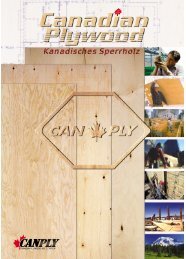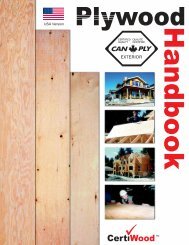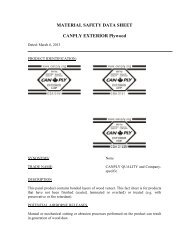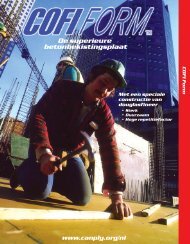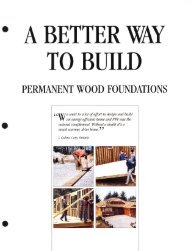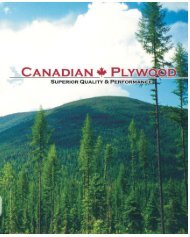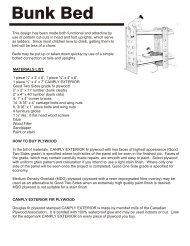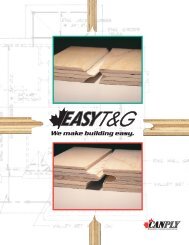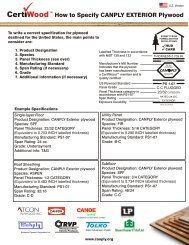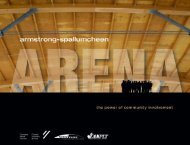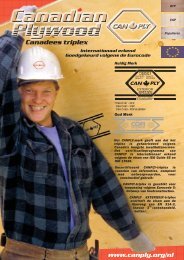Plywood Design Fundamentals - Canadian Plywood Association
Plywood Design Fundamentals - Canadian Plywood Association
Plywood Design Fundamentals - Canadian Plywood Association
Create successful ePaper yourself
Turn your PDF publications into a flip-book with our unique Google optimized e-Paper software.
2012_april revised_48945_en_design.qxd 19/04/2012 3:04 PM Page 9<br />
3.7 Electrical Conductivity<br />
At low moisture content, plywood is normally classified as an<br />
electrical insulator (dielectric), however its resistance to the<br />
passage of electrical current decreases as its moisture content<br />
increases.<br />
3.8 Vapour Transmission (Permeance)<br />
<strong>Plywood</strong> panels provide resistance to the flow of water<br />
vapour, and can be used as a vapour transmission retarder<br />
(VDR). VDRs are rated in terms of their permeance according<br />
to two classes. A Type I VDR has a permeance 14.4 metric<br />
perms (ng/(m 2 •Pa•s)) or less and a Type II VDR has a<br />
permeance of 43.1 metric perms or less before aging and<br />
57.5 perms or less after aging. <strong>Plywood</strong> can be considered<br />
a Type II VDR, with 9.5 mm thick plywood having a permeance<br />
of approximately 40 metric perms. Permeance can be<br />
reduced by coating plywood with aluminum paint or by<br />
application of overlays of low permeability.<br />
3.9 Acoustical Properties<br />
Conventional stud walls sheathed with 7.5 mm plywood (RD<br />
of 0.5) on both sides should reduce sound intensity by<br />
approximately 30 to 36 decibels at room temperature.<br />
Thicker panels are more effective sound insulators.<br />
The sound absorption of 19 mm wood sheathing is approximately<br />
0.10 between the frequencies of 100 to 4100 Hz and<br />
increases somewhat at higher frequencies. <strong>Plywood</strong> may<br />
be expected to behave similarly.<br />
3.10 Cold Bend Radii<br />
Table 7 gives cold bend radii for various thicknesses of<br />
plywood. The figures given are for plywood panels selecte d<br />
at random with no regard to defects such as knots, patches,<br />
and short grain. Without selection or soaking, a small percentage<br />
of panels bent to these radii may be expected to<br />
break. The selection of plywood with a minimum of defects<br />
will permit bending to smaller radii than those shown. These<br />
radii can be further reduced by soaking or steaming the<br />
panel prior to bending.<br />
Table 7. Cold Bend Radii<br />
<strong>Plywood</strong><br />
Thickness<br />
(mm)<br />
6, 7.5<br />
8, 9.5<br />
11, 12.5<br />
14, 15.5<br />
18.5, 19<br />
20.5<br />
3.11 Mass of <strong>Plywood</strong><br />
Bending Axis<br />
Parallel<br />
to Face Grain (m)<br />
0.7<br />
1.0<br />
2.4<br />
3.6<br />
4.8<br />
5.8<br />
Bending Axis<br />
Perpendicular to<br />
Face Grain (m)<br />
1.5<br />
2.4<br />
3.6<br />
4.8<br />
6.0<br />
7.0<br />
These radii are theoretical values only and have not been verified<br />
experimentally.<br />
The mass of plywood primarily depends on the wood<br />
species, but is also affected by the in service moisture<br />
content. For practical design purposes, typical values range<br />
from 500 to 600 kg/m 3 for Douglas Fir plywood, and 400 to<br />
500 kg/m 3 for <strong>Canadian</strong> Softwood plywood.<br />
The mass for typical nominal thicknesses of plywood,<br />
assuming densities of 500 kg/m 3 for DFP and 450 kg/m 3 for<br />
CSP, are contained in Table 8.<br />
9<br />
Table 8. Mass of plywood<br />
<strong>Plywood</strong> Thickness (mm)<br />
7.5<br />
9.5<br />
12.5<br />
15.5<br />
18.5<br />
20.5<br />
22.5<br />
25.5<br />
28.5<br />
31.5<br />
3.12 Fire Performance<br />
The fire performance data for plywood given in this section<br />
are from the National Building Code of Canada. Fire resistance<br />
data (Douglas Fir plywood) are shown in Table 9 and<br />
flame-spread ratings and smoke developed classifications<br />
are given in Table 10.<br />
Table 9. Time assigned to Canply Douglas Fir plywood<br />
Used as Wallboard Membranes*<br />
<strong>Plywood</strong> Thickness<br />
(mm)<br />
8, 9.5<br />
11, 12.5<br />
14, 15.5<br />
17, 18.5 and 19<br />
*Time shown is based on the ability of plywood to stay in place on the<br />
exposed side of the test assembly during fire tests.<br />
**This rating is extrapolated and should not be assumed in design or<br />
implemented in construction without the prior approval of the regulatory<br />
agency or authority having appropriate jurisdiction.<br />
Table 10. assigned Flame-Spread Ratings and Smoke<br />
Developed Classifications*<br />
Materials<br />
Douglas Fir <strong>Plywood</strong><br />
made to CSA O121<br />
<strong>Canadian</strong> Softwood<br />
<strong>Plywood</strong> made to<br />
CSA O151<br />
Minimum<br />
Thickness<br />
(mm)<br />
11<br />
6<br />
11<br />
* These data are based on all presently available evidence.<br />
Interpolation and extrapolation for other plywood thicknesses should<br />
not be done without prior approval from the appropriate regulatory<br />
agency or authority.<br />
** These data are for plywoods without cellulose-resin overlays.<br />
3.13 Formaldehyde Emission<br />
Average Mass (kg)<br />
for a 1220 x 2440 mm panel<br />
DFP<br />
CSP<br />
11.2<br />
14.1<br />
18.6<br />
23.1<br />
27.5<br />
30.5<br />
33.5<br />
38.0<br />
42.4<br />
46.9<br />
Flame-Spread/Smoke Developed**<br />
Paint or Varnish not<br />
Unfinished more than 1.3 mm thick;<br />
Cellulose Wallpaper not<br />
more than one layer<br />
150/100<br />
150/100<br />
150/100<br />
Time<br />
(min.)<br />
5**<br />
10<br />
15<br />
20**<br />
10.0<br />
12.7<br />
16.7<br />
20.8<br />
24.8<br />
27.5<br />
30.1<br />
34.2<br />
38.2<br />
42.2<br />
150/300<br />
150/100<br />
150/300<br />
The phenolic resin adhesive used in CANPLY EXTERIOR<br />
plywood is polymerized (cured or hardened) during<br />
manufacture and becomes an inert substance with<br />
completely distinct characteristics from its individual<br />
components that include phenol and formaldehyde. Testing<br />
by various accredited organizations have shown<br />
formaldehyde levels associated with phenolic resin-bonded<br />
plywood to be extremely low, often below detectable levels<br />
(0.01 ppm). Further info is contained in CANPLY TechNote TN02.<br />
certiWood Canply plywood <strong>Design</strong> <strong>Fundamentals</strong>



